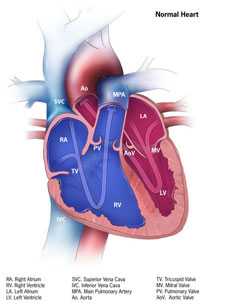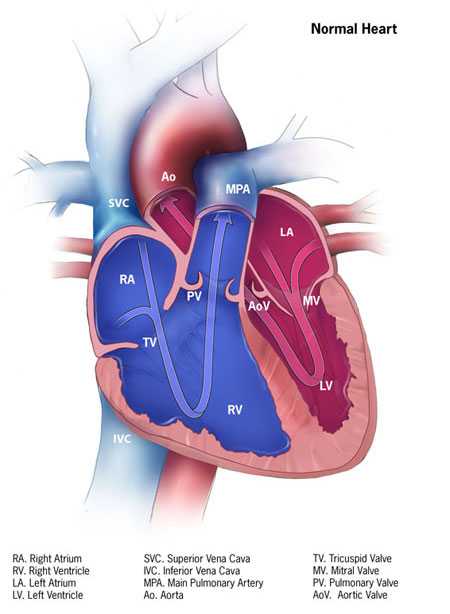How the Heart Works
The heart is an organ, about the size of a fist. It is made of muscle and pumps blood through the body. Blood is carried through the body in blood vessels, or tubes, called arteries and veins. The process of moving blood through the body is called circulation. Together, the heart and vessels make up the cardiovascular system.
Structure of the Heart
The heart has four chambers (two atria and two ventricles). There is a wall (septum) between the two atria and another wall between the two ventricles. Arteries and veins go into and out of the heart. Arteries carry blood away from the heart and veins carry blood to the heart. The flow of blood through the vessels and chambers of the heart is controlled by valves.
Blood Flow Through the Heart
(Abbreviations refer to labels in the illustration)
The heart pumps blood to all parts of the body. Blood provides oxygen and nutrients to the body and removes carbon dioxide and wastes. As blood travels through the body, oxygen is used up, and the blood becomes oxygen poor.
- Oxygen-poor blood returns from the body to the heart through the superior vena cava (SVC) and inferior vena cava (IVC), the two main veins that bring blood back to the heart.
- The oxygen-poor blood enters the right atrium (RA), or the right upper chamber of the heart.
- From there, the blood flows through the tricuspid valve (TV) into the right ventricle (RV), or the right lower chamber of the heart.
- The right ventricle (RV) pumps oxygen-poor blood through the pulmonary valve (PV) into the main pulmonary artery (MPA).
- From there, the blood flows through the right and left pulmonary arteries into the lungs.
- In the lungs, oxygen is put into the blood and carbon dioxide is taken out of the blood during the process of breathing. After the blood gets oxygen in the lungs, it is called oxygen-rich blood.
- Oxygen-rich blood flows from the lungs back into the left atrium (LA), or the left upper chamber of the heart, through four pulmonary veins.
- Oxygen-rich blood then flows through the mitral valve (MV) into the left ventricle (LV), or the left lower chamber.
- The left ventricle (LV) pumps the oxygen-rich blood through the aortic valve (AoV) into the aorta (Ao), the main artery that takes oxygen-rich blood out to the rest of the body.
- Page last reviewed: May 21, 2015
- Page last updated: June 25, 2014
- Content source:


 ShareCompartir
ShareCompartir

